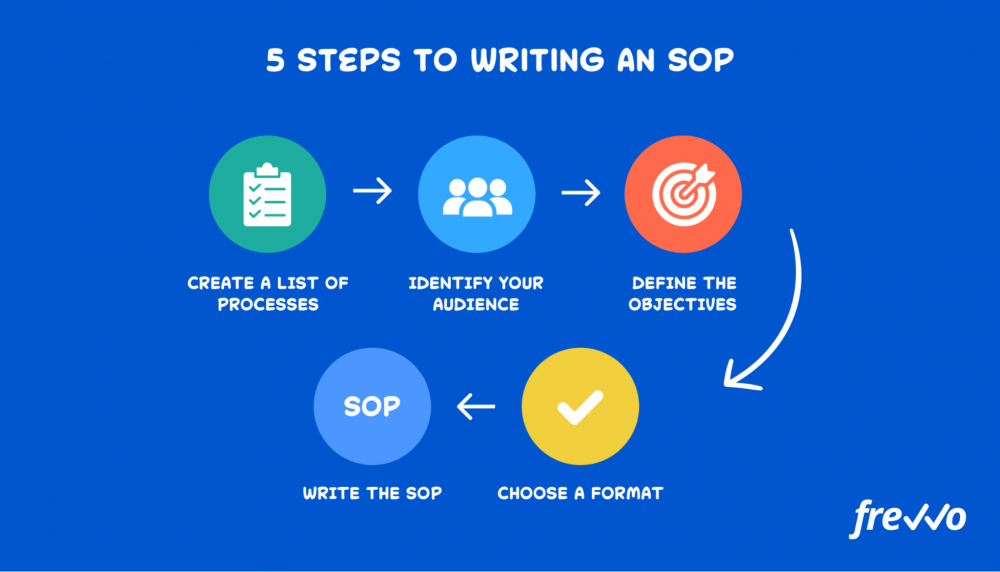
Articles
How to Write SOP Introductions: A Guide for Policy Makers

Are you in search of a method to optimize and regularize your business operations? A standard operating procedure (SOP) could be the answer for streamlining and unifying your business operations. Learning how to write SOP introductions can be challenging, but with some creativity and thoughtfulness, it doesn't have to be.
This article will provide helpful tips on how to capture the reader's attention while conveying all necessary information. We'll also provide tips on best practices for implementing these new SOPs to ensure maximum efficiency throughout your organization. So if you're ready to take control of your operations, let's get started by learning how to write SOP introductions.
What Is a Standard Operating Procedure (SOP)?
Standard operating procedures (SOPs) are written instructions detailing the steps needed to complete a process or activity, with guidance on how to handle various scenarios for optimal efficiency and effectiveness. It outlines how tasks are performed and provide guidance on how to respond in various situations. SOPs provide structure, consistency, and clarity for employees so they can perform their jobs efficiently and effectively.
What Are the Benefits of Having an SOP?
SOPs bring rewards such as greater efficiency, superior customer service, fewer mistakes, adherence to rules and regulations, plus heightened security for personnel and patrons. With well-written SOPs in place, businesses can ensure that all activities are done correctly every time without having to rely on individual knowledge or experience. This helps maintain quality standards while saving time and money.
What Are the Types of SOPs?
Types of SOPs can vary depending on the nature of the task or process being documented.
- Process-based SOPs provide a step-by-step guide for activities such as product assembly or customer onboarding.
- Policy-based SOPs outline guidelines for making decisions about topics like employee discipline.
- Emergency response plans lay out what should be done during crises.
- Data security protocols detail how confidential information should be handled securely.
- Job descriptions define roles and responsibilities within an organization.
To sum up, having a well-defined system of Standard Operating Procedures is essential for any business that seeks to function properly and productively while delivering consistent quality service. By thoroughly documenting processes/policies it ensures that everyone involved understands their responsibilities clearly which leads to fewer mistakes as well as improved compliance with regulations - all adding up to a successful operation.
Now that you're aware of what an SOP is, let's learn how to write SOP introductions.
How to Write SOP Introductions: Content
Learning how to write SOP introductions can be tricky, but businesses need to get them right. The introduction lays out the groundwork for what follows and guides on how processes should be conducted.
Explaining Purpose and Scope
In the introduction, this SOP should explain its purpose and scope, such as outlining procedures related to customer inquiries, feedback collection methods, and issue resolution strategies. This means explaining why you’re creating this policy, what problem it solves, and which departments or employees are expected to follow it.
For example, if you’re writing an SOP on customer service policies, explain that this document outlines procedures related to customer inquiries, feedback collection methods, and issue resolution strategies.
Outlining Processes and Procedures Covered in the SOP
Once you've established why your business needs a certain set of processes outlined in an official policy document like an SOP, provide some detail about what those specific processes are within its introduction section. This will help ensure everyone understands exactly what is expected from them when following these guidelines as well as create consistency across all departments that use this policy.
For instance, if your company has different payment options available for customers such as credit card payments or PayPal transfers, you can outline each process separately so readers know exactly how they should handle these requests going forward.

Identify Key Roles
To make sure everyone knows who is responsible for following each step outlined in your company's standard operating procedure (SOP), it is important to identify any key roles associated with implementing them within its introduction section. Whether that be management staff or frontline employees, list out their titles along with descriptions of their duties related to carrying out these instructions accurately and efficiently. By doing this upfront, businesses can avoid costly mistakes due to miscommunication between teams later on.
Writing an effective SOP introduction is essential for ensuring that your processes and procedures are followed correctly.
How to Write SOP Introductions: Tone
Aside from knowing the SOP format and the content needed in the introduction, we also need to consider the tone of the procedure itself.
Writing an engaging introduction to your SOPs can help make them more interesting and memorable for those who need to use them. When learning how to write SOP introductions, it’s important to consider how you can make them stand out while still conveying the purpose of the document.
Here are some tips on how to write a simple yet effective introduction:
Use Humor Appropriately
Adding humor is a great way to capture readers’ attention, but be sure not to go overboard or use inappropriate jokes. A good rule of thumb is that if you wouldn’t tell the joke in front of your boss, don’t include it in your SOP. Try using puns or clever wordplay instead; these will usually be well-received by most audiences.
An SOP is also an official document. Make sure that the general tone of the document is still professional.
Keep It Short and Sweet
Don't try to cram too much information into one paragraph. Keep things concise so readers won't get bored before they even start reading about the actual procedures outlined in the document. A few sentences should suffice for introducing what's covered in your SOP without going into too much detail.
Make It Relevant To Your Audience
Make sure whatever anecdotes you include are relevant and relatable for those who will be reading them. Otherwise, they may not understand why certain topics were discussed at all. For example, if writing an SOP for customer service agents, consider including examples from customer service scenarios they might encounter daily rather than abstract concepts that have nothing to do with their job duties.
Add Visuals
If appropriate, consider adding visual aids such as diagrams or charts alongside text explanations when possible. This helps break up large blocks of text and makes complex processes easier for people unfamiliar with them to understand quickly. Additionally, visuals can also add some fun elements like colorful graphics that could potentially increase engagement with your audience further.
By keeping your introduction short and sweet, using humor appropriately, making it relevant to your audience, and including visual aids when possible you can create an engaging SOP introduction.
Best Practices for Implementing Your New SOPs
Implementing new SOPs necessitates comprehension and adhesion from all personnel. This can be accomplished through education, observation of adherence, ongoing updates/refresher lessons as required, and soliciting employee input. The best way to do this is through training, monitoring compliance, providing regular updates and refresher training as needed, and encouraging feedback from employees.
To train employees on the new SOPs, start by introducing the concept of SOPs to all staff members. Explain why they are important for efficiency and productivity within your organization. Provide an overview of each procedure so everyone has a general understanding before delving into details.
Once you have provided an overview of each procedure, provide more detailed instructions with examples if necessary so everyone can understand how exactly they should be implemented. This will help ensure that all employees are following the same process when carrying out tasks related to these procedures.
Once the SOPs have been implemented, it's essential to ensure that they are being followed correctly by employing data analytics tools or manual checks. Use data analytics tools or manual checks depending on what works best for your organization. Either way, someone must be keeping track of how well people are adhering to the new processes in place.
Additionally, it’s a good idea for managers or supervisors who oversee certain areas or departments within your company to periodically review their team’s performance regarding SOP adherence to keep things running smoothly across the board.
Conclusion
Learning how to write SOP introductions is critical in engaging employees to comprehend and follow the procedures. Taking the time to craft an engaging yet informative introduction will help make your SOPs more engaging and memorable. By following best practices such as using active voice, avoiding jargon, and keeping things concise you'll have a great start when writing sop introductions that are sure to engage readers.
Are you an entrepreneur, founder, manager, or operational leader looking to scale your business? Trainual is here to help! Our business playbook software is designed to provide superior onboarding, offboarding, and employee training experiences.
We'll ensure that your team members have the knowledge they need for success while streamlining processes and policies. With our customizable solution tailored specifically for you, take control of your organization today with Trainual's top-notch services.
Similar Blog Posts







